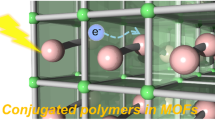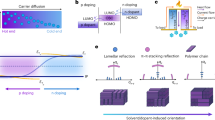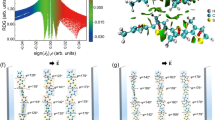Abstract
The emergence of organic semiconductors has laid the foundation for the field of plastic electronics. Controlling π-conjugation by designing proper conjugated moieties is one of the commonest strategies for achieving desired semiconducting properties in conjugated materials. Despite significant advancements in the field, the reversible formation of extended conjugation to in situ switch the nature of macromolecules between semiconductors and insulators remains elusive. Here we disclose a generic strategy for developing polymeric structures that incorporate molecular switch units. These units enable the controlled activation and deactivation of linear conjugation in response to acid–base or electronic stimuli. This is achieved by copolymerizing non-π-conjugated lactone-functionalized xanthene moieties with traditional π-conjugated building blocks. With 2,6-dihydroxynaphthalene as an ‘electro-acid’, the electrochromic-like properties of these polymers were explored, demonstrating an effective in situ conversion of the non-conjugated, colourless polymers into conjugated, coloured polymers.

This is a preview of subscription content, access via your institution
Access options
Access Nature and 54 other Nature Portfolio journals
Get Nature+, our best-value online-access subscription
$32.99 / 30 days
cancel any time
Subscribe to this journal
Receive 12 print issues and online access
$259.00 per year
only $21.58 per issue
Buy this article
- Purchase on SpringerLink
- Instant access to full article PDF
Prices may be subject to local taxes which are calculated during checkout





Similar content being viewed by others
Data availability
All data supporting the findings of this study are available in the main paper, Supplementary Information and source data files. Source data are provided with this paper.
References
Brédas J. L. & Silbey R. Conjugated Polymers: The Novel Science and Technology of Highly Conducting and Nonlinear Optically Active Materials (Springer, 2012).
Reynolds J. R., Thompson B. C. & Skotheim T. A. Conjugated Polymers: Properties, Processing, and Applications (CRC Press, 2019).
Kumar V., Sharma K., Sehgal R. & Kalia S. Conjugated Polymers for Next-Generation Applications, Volume 1: Synthesis, Properties and Optoelectrochemical Devices (Woodhead, 2022).
Heeger, A. J. Semiconducting and metallic polymers: the fourth generation of polymeric materials (Nobel Lecture). Angew. Chem. Int. Ed. 40, 2591–2611 (2001).
Roncali, J. Synthetic principles for bandgap control in linear π-conjugated systems. Chem. Rev. 97, 173–206 (1997).
Beaujuge, P. M. & Reynolds, J. R. Color control in π-conjugated organic polymers for use in electrochromic devices. Chem. Rev. 110, 268–320 (2010).
Yang, J., Zhao, Z., Wang, S., Guo, Y. & Liu, Y. Insight into high-performance conjugated polymers for organic field-effect transistors. Chem 4, 2748–2785 (2018).
Kini, G. P., Jeon, S. J. & Moon, D. K. Design principles and synergistic effects of chlorination on a conjugated backbone for efficient organic photovoltaics: a critical review. Adv. Mater. 32, 1906175 (2020).
Ohayon, D. & Inal, S. Organic bioelectronics: from functional materials to next-generation devices and power sources. Adv. Mater. 32, 2001439 (2020).
Guo, X. & Facchetti, A. The journey of conducting polymers from discovery to application. Nat. Mater. 19, 922–928 (2020).
Pena-Francesch, A., Jung, H., Demirel, M. C. & Sitti, M. Biosynthetic self-healing materials for soft machines. Nat. Mater. 19, 1230–1235 (2020).
MacFarlane, L. R. et al. Functional nanoparticles through π-conjugated polymer self-assembly. Nat. Rev. Mater. 6, 7–26 (2021).
Liu, D. et al. A design strategy for intrinsically stretchable high-performance polymer semiconductors: incorporating conjugated rigid fused-rings with bulky side groups. J. Am. Chem. Soc. 143, 11679–11689 (2021).
Matsuhisa, N. et al. High-frequency and intrinsically stretchable polymer diodes. Nature 600, 246–252 (2021).
Yin, H., Zhu, Y., Youssef, K., Yu, Z. & Pei, Q. Structures and materials in stretchable electroluminescent devices. Adv. Mater. 34, 2106184 (2022).
Gu, C., Jia, A.-B., Zhang, Y.-M. & Zhang, S. X.-A. Emerging electrochromic materials and devices for future displays. Chem. Rev. 122, 14679–14721 (2022).
Pitsalidis, C. et al. Organic bioelectronics for in vitro systems. Chem.Rev. 122, 4700–4790 (2022).
Wu, W. et al. Efficient and modular biofunctionalization of thiophene-based conjugated polymers through embedded latent disulfide. J. Am. Chem. Soc. 146, 578–585 (2024).
Huang, H., Yang, L., Facchetti, A. & Marks, T. J. Organic and polymeric semiconductors enhanced by noncovalent conformational locks. Chem. Rev. 117, 10291–10318 (2017).
Casado, J., Ponce Ortiz, R. & López Navarrete, J. T. Quinoidal oligothiophenes: new properties behind an unconventional electronic structure. Chem. Soc. Rev. 41, 5672–5686 (2012).
Yu, Z. D., Lu, Y., Wang, J. Y. & Pei, J. Conformation control of conjugated polymers. Chem. Eur. J. 26, 16194–16205 (2020).
Bedi, A., Manor Armon, A., Diskin-Posner, Y., Bogosalvsky, B. & Gidron, O. Controlling the helicity of π-conjugated oligomers by tuning the aromatic backbone twist. Nat. Commun. 13, 451 (2022).
Gu, J. et al. Cross conjugation in polyenes and related hydrocarbons: what can be learned from valence bond theory about single-molecule conductance? J. Am. Chem. Soc. 141, 6030–6047 (2019).
Rajca, A., Wongsriratanakul, J. & Rajca, S. Magnetic ordering in an organic polymer. Science 294, 1503–1505 (2001).
Liu, S.-X., Ismael, A. K., Al-Jobory, A. & Lambert, C. J. Signatures of room-temperature quantum interference in molecular junctions. Acc.Chem. Res. 56, 322–331 (2023).
Chen, Z. et al. Mechanochemical unzipping of insulating polyladderene to semiconducting polyacetylene. Science 357, 475–479 (2017).
Steinegger, A., Wolfbeis, O. S. & Borisov, S. M. Optical sensing and imaging of pH values: spectroscopies, materials, and applications. Chem. Rev. 120, 12357–12489 (2020).
Wang, Y., Zhang, Y.-M. & Zhang, S. X.-A. Stimuli-induced reversible proton transfer for stimuli-responsive materials and devices. Acc. Chem. Res. 54, 2216–2226 (2021).
Ponder, J. F. Jr et al. Low-defect, high molecular weight indacenodithiophene (IDT) polymers via a C–H activation: evaluation of a simpler and greener approach to organic electronic materials. ACS Mater. Lett. 3, 1503–1512 (2021).
Rech, J. J. et al. Designing simple conjugated polymers for scalable and efficient organic solar cells. ChemSusChem 14, 3561–3568 (2021).
Rimmele, M., Glöcklhofer, F. & Heeney, M. Post-polymerisation approaches for the rapid modification of conjugated polymer properties. Mater. Horiz. 9, 2678–2697 (2022).
Bell, K.-J. J., Kisiel, A. M., Smith, E., Tomlinson, A. L. & Collier, G. S. Simple synthesis of conjugated polymers enabled via pyrrolo[3,2-b]pyrroles. Chem. Mater. 34, 8729–8739 (2022).
Österholm, A. M. et al. Conquering residual light absorption in the transmissive states of organic electrochromic materials. Mater. Horiz. 9, 252–260 (2022).
Christiansen, D. T., Tomlinson, A. L. & Reynolds, J. R. New design paradigm for color control in anodically coloring electrochromic molecules. J. Am. Chem. Soc. 141, 3859–3862 (2019).
Walczak, R. M. & Reynolds, J. R. Poly(3,4-alkylenedioxypyrroles): the PXDOPs as versatile yet underutilized electroactive and conducting polymers. Adv. Mater. 18, 1121–1131 (2006).
Nhon, L. et al. Theory-driven spectral control of bis-EDOT arylene radical cation chromophores. Chem. Mater. 34, 9546–9557 (2022).
Wagner, J. S., Smith, E., Bacsa, J., Tomlinson, A. L. & Reynolds, J. R. color control in bis-ethylenedioxythiophene phenylene anodically coloring electrochromes. Chem. Mater. 35, 10550–10563 (2023).
Hawks, A. M. et al. Relating design and optoelectronic properties of 1,4-dihydropyrrolo[3,2-b]pyrroles bearing biphenyl substituents. J. Phys. Chem. B 127, 7352–7360 (2023).
Hawks, A. M. et al. Expanding color control of anodically coloring electrochromes based on electron-rich 1,4-dihydropyrrolo[3,2-b]pyrroles. ACS Appl. Opt. Mater. 2, 1235–1244 (2024).
Yen, H.-J. & Liou, G.-S. Solution-processable triarylamine-based electroactive high performance polymers for anodically electrochromic applications. Polym. Chem. 3, 255–264 (2012).
Zhang, Q., Tsai, C.-Y., Li, L.-J. & Liaw, D.-J. Colorless-to-colorful switching electrochromic polyimides with very high contrast ratio. Nat. Commun. 10, 1239 (2019).
Wang, Z. et al. Transparent electrochromic polymers with high optical contrast and contrast ratio. JACS Au 4, 2291–2299 (2024).
Harvey, C. P. & Tovar, J. D. Main-chain photochromic conducting polymers. Polym. Chem. 2, 2699–2706 (2011).
Hassab, S. et al. A new standard method to calculate electrochromic switching time. Sol. Energy Mater. Sol. Cells 185, 54–60 (2018).
Wang, Y. et al. A multicolour bistable electronic shelf label based on intramolecular proton-coupled electron transfer. Nat. Mater. 18, 1335–1342 (2019).
Acknowledgements
We are grateful for financial support from the Fundamental Research Funds for the Heilongjiang Universities (2022-KYYWF-1105). The funders had no role in study design, data collection and analysis, decision to publish or preparation of the manuscript. We thank J. Mei for valuable discussions during the revision of this paper.
Author information
Authors and Affiliations
Contributions
Y.W., J.L. and M.W. conducted the synthetic experiments. Y.W. carried out the materials characterization and device fabrication. J.L. performed the DFT calculations. X.W. and W.C. assisted with the project. K.L. conceived the work and directed the project. K.L. and H.N. directed the electrochromic studies. K.L., Y.W. and J.L. designed the experiments and wrote the paper.
Corresponding authors
Ethics declarations
Competing interests
Heilongjiang University and K.L. Y.W., J.L. and M.W. have filed a patent (2024105595290) that covers aspects of the work reported in this paper. The other authors declare no competing interests.
Peer review
Peer review information
Nature Chemistry thanks Yan Xia and the other, anonymous, reviewer(s) for their contribution to the peer review of this work.
Additional information
Publisher’s note Springer Nature remains neutral with regard to jurisdictional claims in published maps and institutional affiliations.
Supplementary information
Supplementary Information
Supplementary Figs. 1–34, discussion and Tables 1–10.
Supplementary Data
Coordinate data for Figs. 3 and 5.
Source data
Source Data Fig. 1
UV-absorption plot data.
Source Data Fig. 2
UV-absorption plot data.
Source Data Fig. 4
UV-absorption plot data.
Source Data Fig. 5
UV-absorption plot data.
Rights and permissions
Springer Nature or its licensor (e.g. a society or other partner) holds exclusive rights to this article under a publishing agreement with the author(s) or other rightsholder(s); author self-archiving of the accepted manuscript version of this article is solely governed by the terms of such publishing agreement and applicable law.
About this article
Cite this article
Wu, Y., Liu, J., Wang, M. et al. Reversible formation and control of linear conjugation in polymers. Nat. Chem. 17, 1265–1274 (2025). https://doi.org/10.1038/s41557-025-01851-7
Received:
Accepted:
Published:
Issue date:
DOI: https://doi.org/10.1038/s41557-025-01851-7



